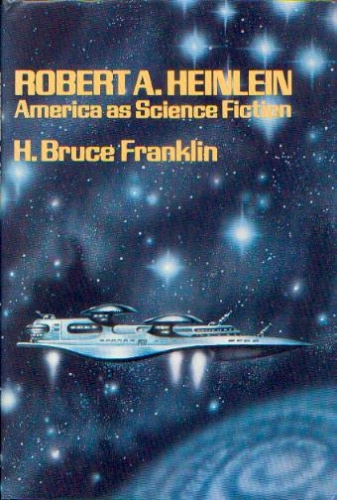The Golden Age of Science Fiction: Robert A. Heinlein: America as Science Fiction, by H. Bruce Franklin

The J. Lloyd Eaton Award was established in 1977 and initially was presented to the best critical science fiction book of the year. It was not presented in 1981, 1992, 1997, 1998, or 2000 and was put on hiatus after the 2001 awards were presented. When the award was started again in 2008, it was no longer given for a critical work, but rather for lifetime achievement. The award is presented at the annual Eaton Conference, held at the University of California at Riverside. The first Eaton Award was presented to Paul A. Carter in 1977 for his book The Creation of Tomorrow: Fifty Years of Magazine Science Fiction. In 1980, the winner was H. Bruce Franklin for his study Robert A. Heinlein: America as Science Fiction.
H. Bruce Franklin’s Robert A. Heinlein: America as Science Fiction was not the first book-length exploration of Heinlein’s life and writings, nor would it be the last, but it did take a unique view of Heinlein’s fiction, breaking his career into five segments and tying them to different aspects of American civilization.
Franklin opens his study with an exploration of Heinlein’s childhood, the small town of Butler, where he was born, and his father, uncle, and grandfather’s employment both there and in nearby Kansas City. Franklin isn’t merely giving background, but as he discusses Heinlein’s childhood, he ties the vicissitudes of his relative’s business ventures to Heinlein’s own take on the American dream and the way things work, or should work.
Once this background is out of the way, Franklin defines five periods of Heinlein’s writing, not only chronologically and thematically, but by tying each one to a specific period of American history. Heinlein’s earliest short stories, for instance, are linked to the Westward expansion and pioneer motif. The second period of Heinlein’s work was his emulation of the dime novels, when he was writing juvenile science fiction. This was followed by a third period which Franklin sees as mirroring the 1960s counterculture, during which Heinlein was writing. The seventies formed the fourth period with Franklin predicting a fifth period of Heinlein’s writing to kick off in 1980, the year following publication of Franklin’s study, with the publication of Heinlein’s own The Number of the Beast.
Franklin has an intriguing way of making his arguments. He describes the plot of various Heinlein stories and novels, not only tying them together and to Heinlein’s overall future history, but also explaining how the individual stories fit into Franklin’s interpretation of Heinlein’s work as reflective of American history. While Franklin’s comparisons are interesting and may even hold some level of factuality to them, the book does suffer from relying too much on detailed descriptions of Heinlein’s work. Since Franklin notes that most of Heinlein’s novels and the short stories he discusses were in print at the time of publication, it almost feels as if Robert A. Heinlein: America as Science Fiction should have been designed more as an accompaniment to the original texts.
Really, the key to the book is less the title and more the subtitle. Franklin is using Heinlein’s life and writings to make his argument, but his real argument can be separated from Heinlein, namely that American history and the American temperament can be seen in science fiction as a mirror, showing the individuality, the myth of exceptionalism, and the various political forces which try to keep the body politic in balance.
There is no record of the other work nominated for the J. Lloyd Eaton Award in 1980.
 Steven H Silver is a sixteen-time Hugo Award nominee and was the publisher of the Hugo-nominated fanzine Argentus as well as the editor and publisher of ISFiC Press for 8 years. He has also edited books for DAW and NESFA Press. He began publishing short fiction in 2008 and his most recently published story is “Webinar: Web Sites” in The Tangled Web. Steven has chaired the first Midwest Construction, Windycon three times, and the SFWA Nebula Conference 6 times, as well as serving as the Event Coordinator for SFWA. He was programming chair for Chicon 2000 and Vice Chair of Chicon 7.
Steven H Silver is a sixteen-time Hugo Award nominee and was the publisher of the Hugo-nominated fanzine Argentus as well as the editor and publisher of ISFiC Press for 8 years. He has also edited books for DAW and NESFA Press. He began publishing short fiction in 2008 and his most recently published story is “Webinar: Web Sites” in The Tangled Web. Steven has chaired the first Midwest Construction, Windycon three times, and the SFWA Nebula Conference 6 times, as well as serving as the Event Coordinator for SFWA. He was programming chair for Chicon 2000 and Vice Chair of Chicon 7.
I’m not 100% certain I actually read the book, but I definitely recognize that cover!
I was fortunate to be a student of Franklin’s–his graduate seminar on science fiction rekindled my interest in the genre and directly inspired my seeking gigs during the late adolescence of the Internet (circa late 1990s early 2000s) writing on the topic. For additional reference, go to the bottom of this SF Site review for a listing of key Franklin works on science fiction: https://www.sfsite.com/07b/drea37.htm
David — that’s a great link, and a terrific resource. Thanks for sharing it!